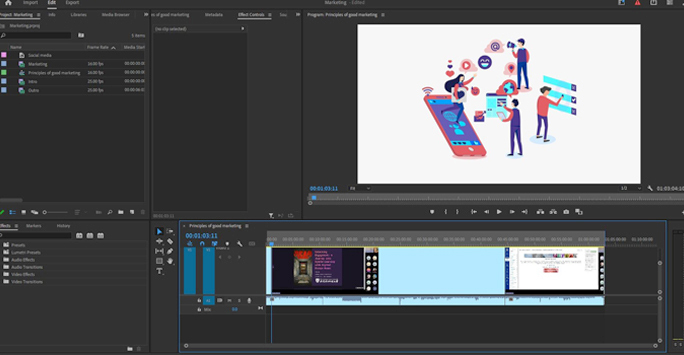In a rapidly digitalising world, enhancing digital fluency has become more crucial than ever for students. This case study explores how the integration of Adobe Creative Cloud into the curriculum is revolutionising the educational landscape. Led by Dr Ahmed Al-Abdin and a team of multidisciplinary experts, the study delves into the impacts of active learning and authentic assessment methods. It demonstrates how these pedagogical approaches, when complemented by digital tools, not only enrich the learning experience but also better prepare students for the challenges of the modern workplace.
Please briefly describe the activity undertaken for the case study
In the professional world, employers are frequently asking of graduates to have knowledge of creative software such as Adobe Creative Cloud (ACC) and its relevant digital tools. This is particularly true in Management and relevant sister disciplines such as Marketing.
Recognising the inherent significance of digital proficiency within the Liverpool Curriculum Framework and its direct influence on employability, we sought to integrate the use of ACC software. This project aimed to pioneer innovative approaches within the curriculum, especially as we transition beyond the pandemic's 'disaster stage'.

Added to this, module and programme leaders are keenly exploring authentic, alternative assessment methods, including posters, videos, vlogs, blogs, infographics, and other formats beyond the traditional essay. These methods necessitate the use of digital tools like ACC to produce dynamic and captivating multimedia content that demonstrates applied knowledge and understanding. The overall objective was therefore to enhance students' creative capacities, digital skills, and problem-solving abilities using industry-standard multimedia production software.
How was the activity implemented?
Upon initiating our project, we quickly realised there were no dedicated University departments equipped to offer regular workshops on ACC to students. Our initial strategy was to recruit final-year Marketing students as ambassadors, though this faltered due to exam pressures, resulting in reduced interest.
Changing plan, we sought external expertise and partnered with FB Creative, a marketing agency, to design and deliver our workshops. To ensure quality and effective engagement, we capped each workshop at 30 participants. These participants were required to attend all four sessions, bring their laptops or borrow a device for enhanced interactivity, and engage with preparatory materials shared prior to sessions in a flipped-classroom model.
The project started in the early weeks of Semester 2, with students attending fortnightly 2-hour workshops. The existing provision of ACC licenses to Marketing students enabled us to align our workshops to the assessment needs of both undergraduate and postgraduate Marketing courses. Many of these courses, such as MKIB255, MKIB256, and MKIB340, had existing assessment approaches requiring poster or video outputs.
While time constraints prevented a formal pilot test, this initiative can be viewed as a foundational trial. The insights gathered will be instrumental for developing future projects. Our school, University of Liverpool Management School (ULMS), is now exploring the integration of ACC across its entire undergraduate curriculum. This is significant, as several modules, like MKIB255 and MKIB256, are taken by students from other disciplines, amplifying the need for an inclusive approach.
Given the project's limited duration, we prioritised teaching certain ACC tools that aligned with the students' assessment needs. Adobe Photoshop and Premiere Pro were at the forefront due to their relevance to poster/infographic and video assessments, respectively.
FB Creative played an active role in maintaining student engagement. Students had opportunities to present their work, receive formative feedback, and refine their outputs. Impressively, approximately 90% of participants submitted work for review, with FB Creative providing valuable feedback in subsequent sessions.
Has this activity improved programme provision and student experience, and if so how?
The integration of ACC into the curriculum undeniably enriched the academic framework and amplified the student experience. Introducing ACC tools facilitated a more robust and diverse pedagogical approach, particularly in the realms of Management and Marketing.
By focussing on authentic assessment methods, students were equipped with a broader array of multimedia outputs, from videos and posters to infographics. This move not only diversified their skills set but also mirrored the demands of contemporary professional sectors. Collaborating with FB Creative elevated this endeavour. Their structured workshops ensured that students received hands-on, industry-relevant exposure to ACC. Crucially, aligning these sessions with impending course assessments allowed students to apply their skills immediately, enhancing the relevance of their learning.
A notable highlight was the feedback process from FB Creative. With nearly 90% of participants actively seeking feedback, this iterative process significantly bolstered their learning experience.
Did you experience any challenges in implementation and if so how did you overcome these?
Initially, we aimed to offer this project to the entire University of Liverpool community through extracurricular workshops hosted at the Management School. However, we soon encountered a hurdle: the university does not possess a universal subscription to ACC. Given the financial implications of procuring such a subscription, we would recommend that the university explore options for acquiring institutional licences at discounted rates. Upon investigation, it was evident that only Undergraduate and Postgraduate Marketing students had access to the software, thus narrowing our potential participant pool. Given these constraints, we proceeded by focusing on the Marketing students for this foundational pilot to fully utilise the funding available.
Another challenge arose when we attempted to hire final-year Marketing student ambassadors, hoping they could leverage their ACC knowledge to facilitate the workshops. Recruitment fell short, primarily due to the heavy assessment workload these students faced in their final year. This shortfall led us to a realisation: we needed professionals with existing ACC expertise. With a noticeable absence of such accessible expertise within the university, we sought external assistance.
How does this case study relate to the Hallmarks and Attributes you have selected?
This case study resonates deeply with the Liverpool Hallmarks of active learning, authentic assessment, digital fluency and indirectly with research-connected teaching. The integration of ACC into our curriculum not only promotes active engagement with digital tools but also facilitates an environment where students can produce genuine, industry-relevant outputs such as posters, videos, and infographics.
The ACC workshops included components of active learning. By breaking down training into manageable segments, and managing a flipped-classroom approach, we ensured that students engaged without feeling overwhelmed in the synchronous sessions, fostering a more inclusive learning environment. Any issues raised prior to these sessions could be addressed. This feedback process led to themes raised by students in the pre-session activities being explored further as supplementary workshop content.
The drive behind this initiative was to provide students with the tools they need for authentic assessment. ACC allows students to produce outputs that mirror real-world tasks, equipping them with skills directly transferable to their future careers. With regards to digital fluency, ACC serves as a fundamental digital platform. It is not only a tool used by professionals in graphic design and digital marketing but is also becoming a sought-after skill across various industries. Moving beyond basic software to the creation of rich multimedia content and artefacts is essential in today's digital age.
ACC also introduces students to the world of generative AI, bridging the gap between human creativity and automated design. Using tools like Photoshop, students can merge AI-generated content with their own insights, allowing them to produce rich, unique outputs. This harmonisation of human creativity and AI not only enhances digital fluency but also paves the way for innovative solutions to traditional assessments.
How could this case study be transferred to other disciplines?
ACC's adaptability and comprehensive toolset make it a go-to for any discipline striving to weave creativity, collaboration, and authenticity into their pedagogical approach. The versatility of the software is not limited by discipline or profession, positioning it as an invaluable asset for a range of academic fields.
For example, its capacity to facilitate and enhance creative, authentic assessment outputs offers an alternative to more traditional, formulaic methods like examinations and essays. This is now in increasing demand across disciplinary faculty. In short, ACC's tools are not confined to any one subject area, making it a universal asset for diverse academic fields. This adaptability means disciplines seeking to diversify their assessment strategies can seamlessly incorporate ACC. For instance, disciplines such as History could leverage ACC to craft interactive timelines, while Environmental Science students might use it to visualise complex ecological data through engaging infographics.
Where multimedia elements are pivotal to formative or summative evaluations, ACC emerges as an indispensable resource. Film studies students could harness the power of Premiere Pro for their documentary projects, whereas Literature enthusiasts might tap into Illustrator to give classic texts a visual twist. Beyond its multimedia prowess, ACC's collaborative capabilities shine in disciplines valuing group projects and collective efforts. Business and Marketing students could collaborate in real-time to design compelling marketing campaigns, and Engineering cohorts might jointly create design mock-ups for practical ventures. ACC also holds potential for fostering interdisciplinary projects, as teams could collaborate to combine visual design with scientific data in a quickly growing area of data science presentation.
If someone else were to implement the activity within your case study, what advice would you give to them?
For those considering implementing the activities highlighted in our case study, there are several key pieces of advice to bear in mind. Begin by engaging in discussions at both university and faculty levels about the strategic significance of acquiring access to ACC licences for students and staff. Exploring this avenue may not only be financially beneficial but could also offer us a competitive edge, especially when compared to rival institutions with institution-wide ACC licences.
When considering alternative platforms to ACC, such as Canva, it is vital to weigh the costs against the benefits. Though Canva is free to some degree of use, its functionality,
accessibility and design choices are somewhat limited. Consequently, it does not match the versatility and creative potential that ACC offers.
Organising a programme workshop provides an opportunity to evaluate the feasibility and potential impact of integrating ACC across the curriculum. It is an occasion to brainstorm, gather insights, and assess the broader implications including areas of inclusivity and accessibility. Understanding how students will access and use the software, and how they can be supported in doing so was paramount to our project’s planning. Where students required further support in this project, this was offered in the way of direct feedback and an exploration of assistive technology from both the partner agency and the University team.
Leveraging internal expertise is an important and cost-effective approach. Before turning to external agencies for support, consider consulting further with university colleagues and departments including IT Services and the Centre for Innovation in Education. There might be more students or staff with ACC proficiency willing to contribute to your project, potentially saving considerable resources and cost. Customisation is also key. When planning workshops, adapt the content to the specific discipline in focus. This ensures that the material is relevant and relatable, which in turn fosters greater student engagement.
Finally, it is crucial to promote an awareness of ACC or similar software's potential within the curriculum as part of an evaluative and reflective cycle. This not only garners further interest but also lays the groundwork for broader acceptance and integration in the future.

Enhancing and embedding digital fluency in the curriculum through Adobe Creative Cloud by Dr Ahmed Al-Abdin, edited by Rob Lindsay is licensed under a Creative Commons Attribution-NonCommercial 4.0 International License.
